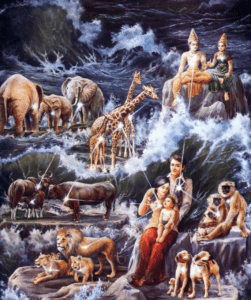6. Sastha-yama Sadhana
Bhajana during the evening
Bhava
(The transcendental emotion)
The external symptoms of perfection are found in the Siksastaka (6):
nayanam galad-asru-dharaya
vadanam gadgada-ruddhaya gira
pulakair nicitam vapuh kada
tava nama-grahane bhavisyati
O Lord, when will my eyes be adorned with an incessant flow of tears of love while reciting Your holy names? When will my words break as I utter Your holy names, and when will the hairs on my body stand up to the chanting of Your holy names?
Without love for God, my life is useless. So, I pray that You will accept me as Your servant, and that You will give me the reward of ecstatic love for God.
The form of bhava is described in Bhakti-rasamrta-sindhu:
premnastu prathamavastha
bhava ity abhidhiyate
satvikah svalpa-matrah syuh
kampasru-pulakadayah
The first level of prema is known as bhava, where the eight sattvika vikaras (bodily transformations), such as growing hair and crying, manifest in a mild way.
If love for Krishna in the seed state has fruited in one’s heart, one is not shaken by material things. Not a moment should be lost. Every moment is used for Krishna or connected to Him. In the material field, people are interested in material enjoyment, mystical powers and sense gratification. These things, however, are of no interest to the devotee. Although the qualities of the devotee are above all, he considers himself to be at the lowest level of life. A completely abandoned devotee always hopes that Krishna, the Lord, will be kind to him. This hope is deeply rooted in him. This fervor is characterized mainly by the ardent desire to obtain the mercy of the Lord. Due to a great taste for the holy name, one is inclined to constant chanting of the Hare Krishna maha-mantra. At this level of bhava, a devotee has awakened the tendency to chant and describes the transcendental qualities of the Lord and feels attachment to this method. A devotee absorbed in ecstatic emotion for Krishna always wishes to live in a place where Krishna’s pastimes took place. These are the symptoms of a person who has developed attraction (bhava) for Krishna.
The various anubhavas that manifest when experiencing bhava are listed in the Bhakti-rasamrta-sindhu:
nrtyam viluthitam gitam
krosanam tanumotanam
kunkaro jrmbhanam svasa-
bhuma lokanapeksita
lalasravo ‘ttahasas ca
ghurna hikkadayopi ca
Dancing, falling and rolling on the ground, singing and crying very loudly, body contortions, severe tremors, yawning, panting, ignoring others, saliva, mad laughter, spitting, hiccups and other similar symptoms are called anubhava.
Asta-sattvika vikaras are also exhibited in Bhakti-rasamrta-sindhu:
te stambha-sveda-romancah
svara-bhedo ‘tha vepathuh
vaivarnyam-asru-pralaya
ity astau sattvikah smrtah
The eight symptoms of bhava are: fainting, shaking, sweating, erection of hair, turning pale, crying, sobbing and devastation.
The living entity in his siddha-deha is Krishna’s eternal servant. When attachment for service is manifested, false identification with the material body diminishes. In the Padyavali we find the following statement of Sri Caitanya Mahaprabhu:
naham vipro na ca nara-patir napi vaisyo na sudro
naham varni na ca grha-patir no vanastho yatir va
kintu prodyan-nikhila-paramananda-purnamrtabdher
gopi-bhartuh pada-kamalayor dasa-dasanudasah
I am not a brahmana, I am not a ksatriya, I am not a vaisya, nor am I a sudra. I am not even a brahmacari, a householder, a vanaprastha or a sannyasi. I only identify myself in the role of the servant of the lotus feet of Lord Krishna, the Lord, the protector of the gopis. He is an ocean of nectar, and is the cause of universal transcendental happiness, and always exists with splendor.
This is a section of the book “Bhajana Rahasya”.
To buy the complete book, click above



